16 Types Of Melons, Explained
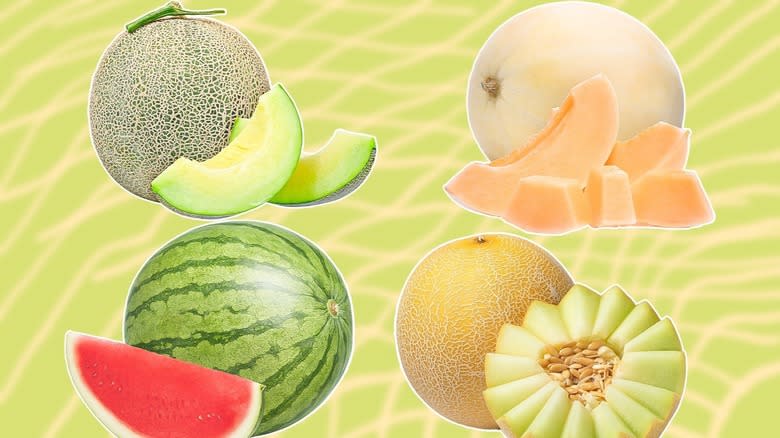
Rich and juicy, melons are powerhouses of both flavor and nutrition. They're part of the gourd family Cucurbitaceae, which also includes pumpkins and squash, and those that are sweet belong to a subcategory called muskmelons. In other words, there are many varieties available, so you can easily find ones that suit both your palate and cooking style.
Melons have a higher water content than other fruits, up to 90% for some, and eating them is a great way to hydrate. Rich in vitamins, minerals, and fiber, nearly all melons are also low in calories and are loaded with antioxidants. They're generally safe to eat if you're not allergic, but certain melons, like watermelons, contain a type of carbohydrate called FODMAPs, so those with irritable bowel syndrome may not be able to tolerate them. Most melons are also high in sugar, so anyone who wishing to limit their sugar intake may want to eat them in moderation.
You can add melons to many recipes, from mint and melon fruit salad to even savory recipes. Here are 16 types of delicious, nutritious melons, starting with those easiest to find in the U.S.
Read more: 13 Simple Tricks To Pick The Best Fresh Fruit Every Time
Cantaloupe
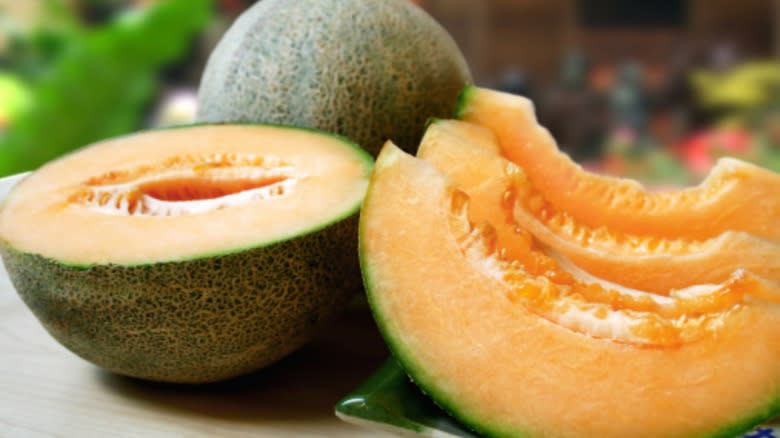
This juicy melon is found on many nutritious meal plans because it's full of antioxidants, minerals, and vitamins, not to mention a healthy dose of water. Its orange flesh has a unique snap of flavor. In Cavaillon, France, dubbed the melon capital of the world, cantaloupes are celebrated at its annual melon festival. This melon is so beloved that in the 1980s, the Knights of the Order of the Melon were formed to manage the town's local variety of cantaloupe, charentais.
To select a ripe cantaloupe, pick one that has a symmetrical shape. The skin should be firm and free of bruising. While the melons are available all year, they taste best in season, from June through October. Cantaloupes are delicious but not nearly as sweet as the dessert table favorite, honeydew. You won't find them in dishes like pies or sweet desserts, but if you're tired of eating them fresh, you can make a refreshing chilled cantaloupe soup.
Honeydew
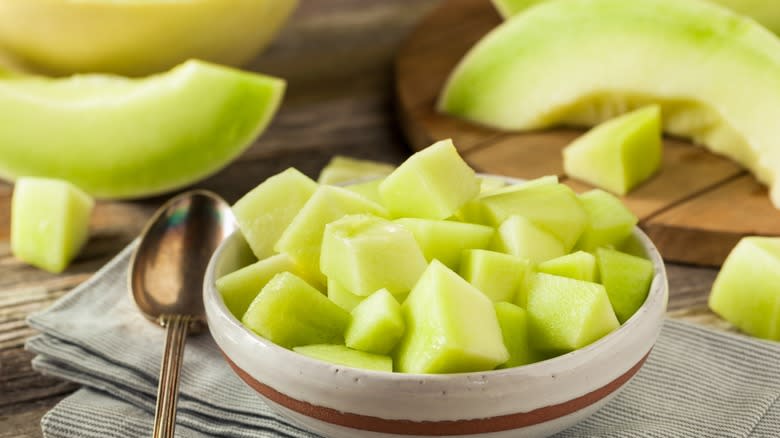
Honeydews are the sweetest melons you can buy, with 8 grams of sugar per 100 grams of melon. However, they are relatively low on the glycemic index, a scale which rates how quickly food raises the body's blood sugar levels. Honeydews have similar health benefits as cantaloupes since they are also rich in vitamin C and K, potassium, magnesium, fiber, and antioxidants. They also have vitamin B1, calcium, iron, and zinc.
These green-fleshed melons are in season from July through September, making them the ideal summer party dessert. To select a good one, pick a honeydew that is symmetrical, heavy, and free of deformities, discoloration, or cracks. The melon should also smell sweet and have a little give when you squeeze it.
The natural sugary flavor of these melons makes them a good addition to fruit salads and honeydew cocktails, but you can also give honeydew a savory twist by pickling it. Honeydew is perfect when wrapped with prosciutto, sliced with cucumber, or served with basil. It's a delicious treat, but in summer, watermelon might be the best option for dessert.
Watermelon
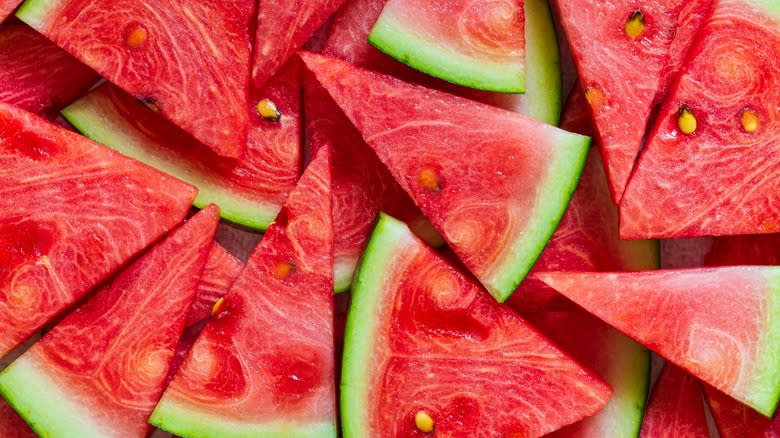
Watermelon is a summertime favorite in the U.S., but did you know that there are more than 1,000 varieties of this fruit? These include typical-looking seeded watermelons, unseeded ones, and small-sized personal varieties, small enough for one person to eat. There are also rare giant watermelon varieties, reaching hundreds of pounds in weight.
To choose a ripe watermelon, first find the field spot, where it sat on the ground as it grew. The spot should be yellow to orange for best flavor, but paler colors have less taste. Make sure the melon has even, consistent striping. Then knock on it and listen. A noticeably hollow sound means it's ripe. And it if has dry lines or weathering, it's actually sweeter. As with all melons, roundness and weight mean better flavor.
Although not as sweet as honeydew, watermelon contains 6.2 grams of sugar per 100 grams of melon. There are too many delicious ways to eat a watermelon to list them all. You could use watermelon for granitas, sorbets, gazpacho, and more, but before we move on, we'll recommend slicing the flesh into cubes and dredging it in cacao powder for an indulgent treat.
Galia Melon
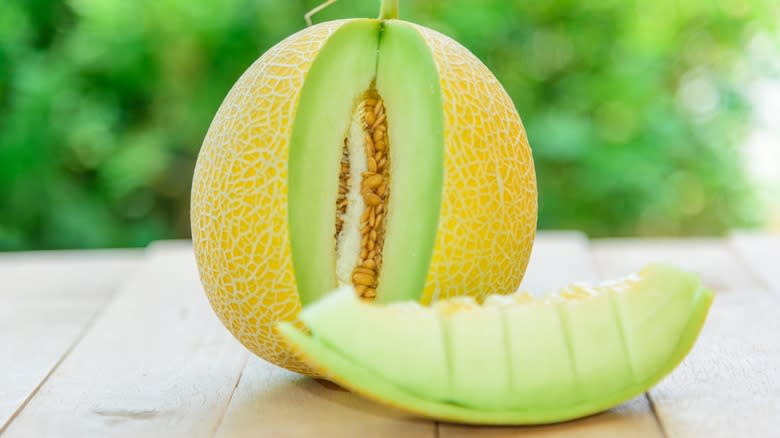
Galia melons are hybrids of cantaloupe and honeydew, named for the daughter of the man who first bred them. They feature the sweetness of honeydew combined with the aromatics of cantaloupe, making them milder than other melons. They're also a good choice for those who like the flavor of honeydew but want to tone down the sweetness. As usual, Galia melons are full of nutrients, including vitamins A, C, and K, antioxidants, minerals, and plenty of water.
When a Galia melon is ripe, its rind is yellow-orange in color rather than green. Pick a melon with a sweet and musky scent and a stem that gives little when you push on it. Avoid bruises and spots on this variety. You can substitute Galia melons in your cantaloupe or honeydew recipes or mix them with ginger to make a crisp homemade jam. We think they're a great way to liven up any melon recipe.
Banana Melon
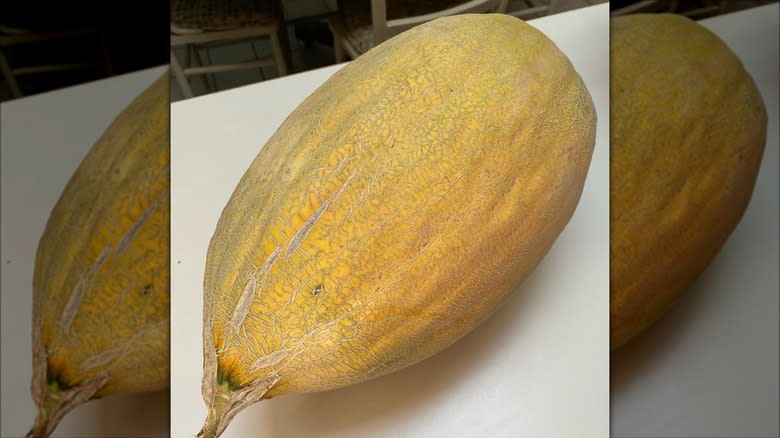
Banana melons are related to cantaloupes and cucumbers but look more like a cross between a papaya and a banana. They also resemble squash. Their flesh is similar to cantaloupe in appearance but like papaya in texture.
Banana melons have a taste that suggests both banana and cantaloupe and has been described as both spicy and sweet. This fruit is an heirloom variety, meaning its seeds have been passed down for decades, since at least the 1880s. Like other melons, it is rich in nutrients, with vitamins C, B3, B6, B9, and K, plus potassium and iron.
Banana melons may be difficult to find, but there's plenty of information out there on how to grow this vining plant. Be careful, though: The melons can grow up to 24 inches long, so you'll need some space to accomplish this. If you love bananas and cantaloupe, we recommend you try them if you can find them.
Casaba Melon
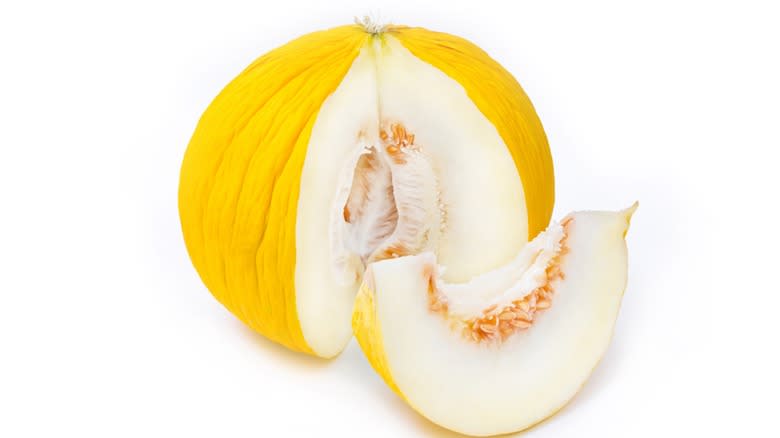
The ripened casaba melon is bright yellow with thick, wrinkly skin. The fruit weighs about 3 to 5 pounds and is sweet with a pleasant aroma. The unique thing about this melon is its pale green flesh, which is reminiscent of cucumber and honeydew. It has notes of both pear and pineapple in its crisp flesh, and it has been described as musky, making it stand out from other melons on this list.
To ensure you are buying a ripe casaba melon, as usual, look for a heavy fruit with a noticeable aroma and skin that is a little soft when you press it. If you have one that isn't quite ripe, let it ripen on your counter for two to four days before cutting. Casaba melons work in the same recipes as other melons, like fruit salads and smoothies, but its unique taste also works well with curry, salsa, and ginger recipes, or on charcuterie boards. The casaba melon is also the parent of a great hybrid: the Crenshaw melon.
Crenshaw Melon
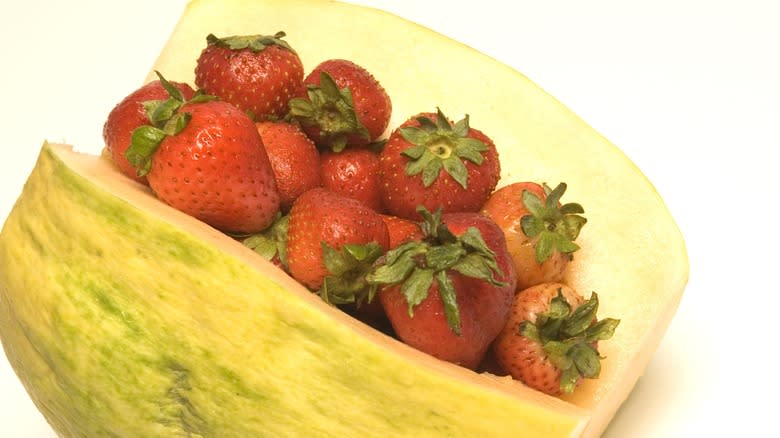
The Crenshaw melon is a hybrid of casaba and Persian melons. This is where things get a bit complicated, because some people also call it the Persian melon while others call cantaloupes Persian melons, as well. These melons are all similar in origin and characteristics, but each is a different cultivar, making them hybrids as opposed to varieties found in nature. This practice is pretty common for melons, hence the confusion.
Named for John Crenshaw, who developed it in the 1800s, this melon is sugary and juicy. It also has a unique peachy flavor with a hint of tartness. The taste of the crisp, pink flesh is reminiscent of cantaloupe and honeydew, with a creamy mouthfeel.
To make sure you are selecting a ripe Crenshaw melon, the skin should be completely yellow and give a little when pushed. Look for the typical clues: heaviness, hollow sound, and aroma. Crenshaw melons can be drizzled with honey for added sweetness. Like most melons, they also go well with cucumber in a salad, especially if you add feta cheese. You can also add Crenshaw melon to a savory stir-fry dish.
Kiwano
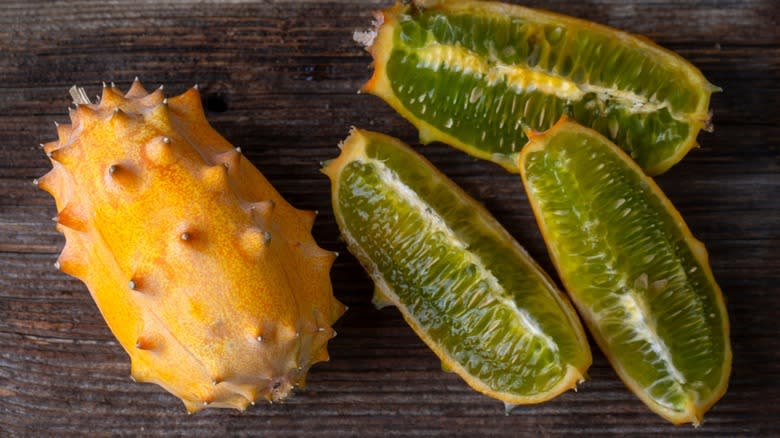
Also called horned melon and African horned cucumber, this melon comes from central and southern Africa. As the names imply, its orange outer shell is dotted with little horns, but don't be intimidated by it. The flesh is unusual, too, with a bright green or yellow hue and a gelatinous texture. It's also studded with seeds.
Like other melons, kiwano is rich in nutrients like vitamins, minerals, antioxidants, and fiber. On top of that, 16% of its calories from protein, which is quite high for a fruit. The flavor is unique and has been compared to cucumber. Others claim it has hints of banana or kiwi.
When it's ripe, the fruit changes from a bright green to orange, so you'll know right away if it's ready to eat. The entire melon is edible, from rind to seeds, but some might prefer to stick to just the flesh. Once you cut it, you can spoon it out to eat it. Feel free to add a bit of sugar or salt. Another way to serve kiwano is to scoop it on top of yogurt or ice cream. It's also a great melon to work into cocktails and mocktails, as well as sauces and dressings that fit well with melon flavors.
Christmas Melon
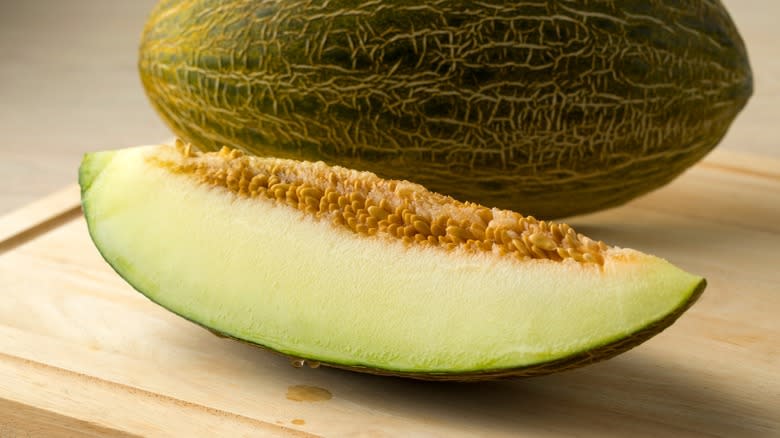
The Christmas or Santa Claus melon is also called piel de sapo, which means "toad skin" in Spanish. This name comes from the light and dark green patches on its rind, but don't be put off by that. While the outer shell does resemble toad skin, overall, this melon is similar to a watermelon in shape and size.
Although it is in season September through October, it's one of the few melons that can be stored through Christmas, hence the holiday-themed names. For storage, keep a ripe Christmas melon cool but don't repeatedly pull it in and out of the fridge, which can cause dark spots on the skin.
Christmas melons have similar nutritional value to other melons. Because the skin is so thick, you won't be able to tell if it's ripe by the aroma, but you can press on the stem to see if it gives. The flesh inside is pale yellow or pale green, and the taste is similar to honeydew, although some say it tastes sweeter. In addition to being a fun winter holiday surprise, piel de sapo goes well with a variety of dishes, especially salads and salsas. It also pairs well with lime, cilantro, and red onion.
Winter Melon
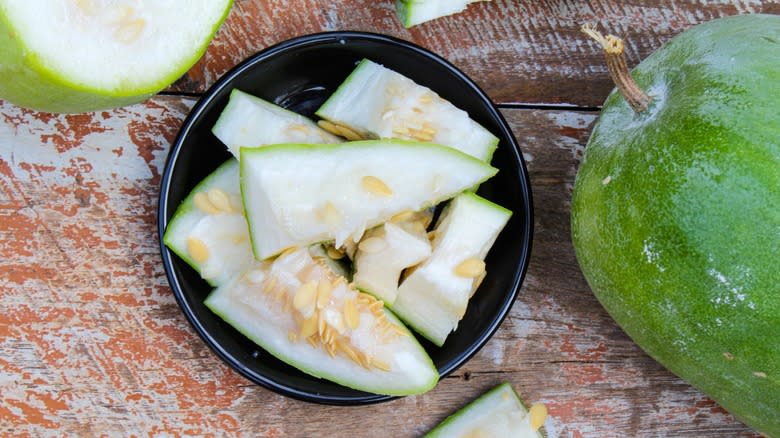
Many melons are rich in flavor, but if you're looking for something with a milder taste, let us introduce you to the winter melon. Like the Christmas melon, this melon earned its name because it can last in storage through the winter, even though it's in season summer through fall. Externally, winter melons resemble watermelons with white flesh inside, and their taste is close to the flavor of watermelon flesh near the rind.
The unique thing about winter melons is that they can't generally be eaten raw. Steaming, simmering, or parboiling are the best ways to get this ingredient into your dishes. Just don't overcook winter melon because you'll ruin its texture and end up with a pot of mush. You can also candy or puree it. Either way, remove the seeds before you cook it.
Also called ash gourd, this fruit is used in Chinese and Indian cuisines. One example is winter melon soup, a Chinese recipe made with dried mushrooms and ham. On the sweet side, there's Chinese wife cake and an Indian candy called petha. In American dishes, winter melon is a good substitute for zucchini.
Canary Melon
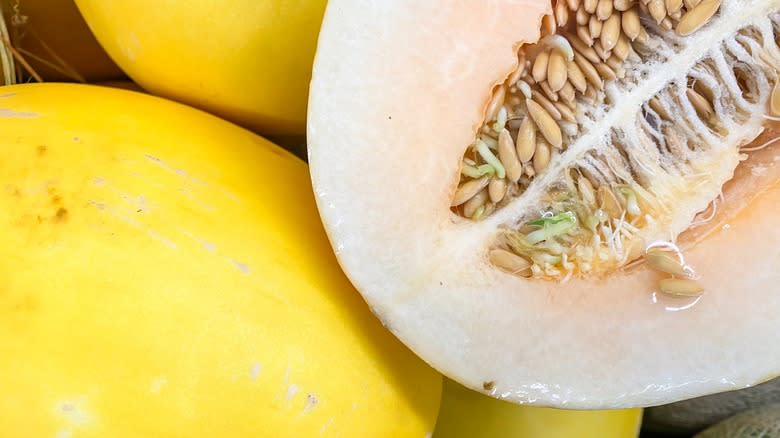
Canary melons are named for their bright yellow rinds. The flesh is pale yellow, featuring a mild sweet flavor with a bit of tartness. Although some people call this variety winter melon, it's distinct from the ash gourd.
Weighing 2 to 5 pounds, canary melons are best bought when they are bright yellow — and the bigger, the better. Avoid any that are discolored or have spots or wrinkles, as those are signs this melon is past its prime. Store it in your refrigerator's crisper drawer, where it will last for up to two weeks.
You can eat canary melon raw and add it to salads and salsas. Its flavor profile blends well with honey, lime, and herbs, including mint and cilantro. Canary melons are also great for grilling -- the caramelization that results will enhance the sweetness. You can also make jam, jelly, or pie filling out of this melon for an outstanding dessert.
Korean Melon
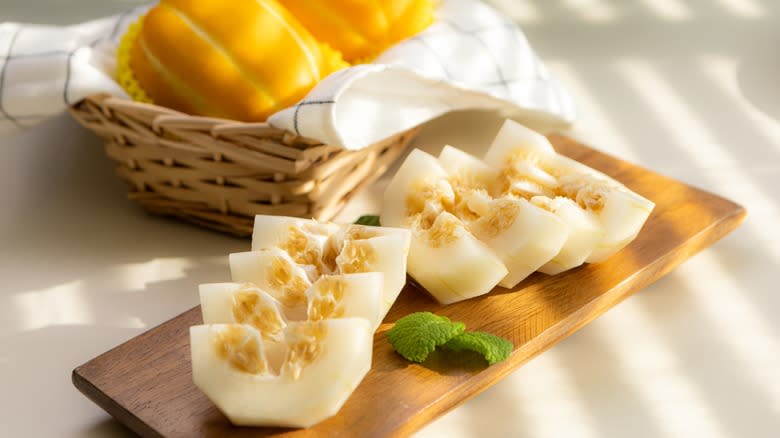
This fruit is, naturally, popular in Korea and is also grown in Japan, China, Hawaii, and California. Known as chamoe in Korea, these bright orange and yellow striped melons are small, fitting in the palm of your hand.
The Korean melon also features a thin skin, like a cucumber. This is why the most common way to eat it is whole, including the seeds and pulp, although you can use a peeler to remove the skin if you prefer. The flesh is somewhat crisp, with its sweetness lying halfway between a honeydew and a cucumber.
The best place to find Korean melons outside of Whole Foods is an Asian grocery store. You'll know the melon is ripe when it feels heavy, smells sweet, and gives when you press into it. Since Korean melons are best eaten fresh, you can add them to salads and smoothies. They're also perfect for chilled melon soup.
Bitter Melon
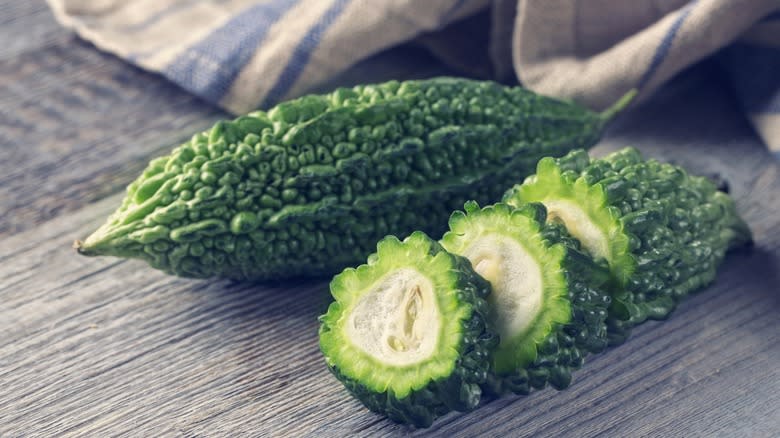
Bitter melon got its name from the bitter flavor of its flesh, and it doesn't even look like a typical melon but rather like a long, green, spiky pod. Before you write it off, though, you should know that plenty of people enjoy the melon's flavor once it's cooked enough to remove the bitterness. This melon has a long history in traditional Chinese medicine, often used as a remedy for diabetes. Because of its purported medicinal properties, bitter melon is often available as a supplement. Fresh melons can be difficult to find, so look for them at an Asian or Indian grocer.
Common recipes for bitter melon include pachad, a cucumber yogurt sauce from South India which is also seen as a remedy for diabetes, as well as curry dishes. In some areas of India, bitter melon is pickled or fried. Chinese chefs also fry this melon alongside meat.
Montreal Melon
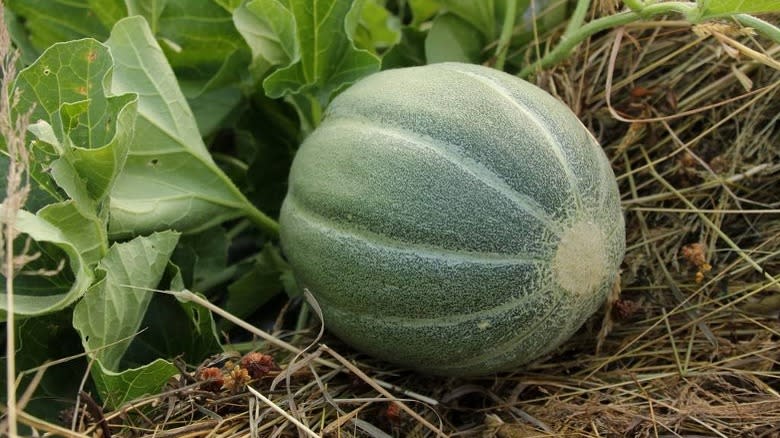
The Montreal melon is notable for the high price it once commanded. During the early 20th century, a slice of Montreal melon was as expensive as steak. The high price was caused by its rarity. This melon was originally cultivated around Montreal, growing as large as 40 pounds. As urban development ate away at the farmland, the melon eventually disappeared.
In 1991, Montreal journalist Barry Lazar, who'd originally believed the seeds were completely gone, tracked some down in the U.S. Department of Agriculture's seed collection. He sent some to an organic farmer in Canada, who succeeded in reviving the melons despite the harsh climate.
When the farmer could no longer maintain the crops, a group of nearby Trappist monks who were also farmers took over the project. Now, they grow up to 40 melons a year, as food for their abbey, naturally. You might not find the Montreal melon in stores, but you can buy seeds online to grow on your own.
Crown Melon
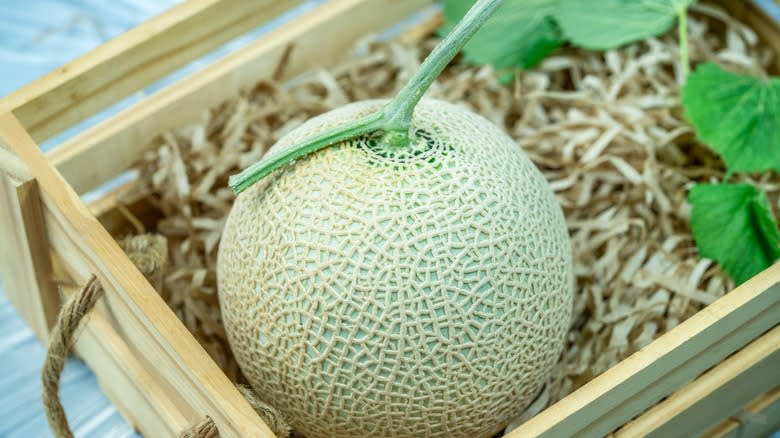
Crown melons hail from Japan and cost a fortune! A crown melon, sometimes called the King of Melons, can cost $200, but why?
These melons are exclusively grown in Japan's Shizuoka Prefecture. This area has an ideal climate all year long and gets the most sunshine of any region of the country. Crown melons are grown using a method called "One Tree, One Fruit." For each of their 100 days of cultivation, the plants are cared for by hand, from pollination to watering. They're also pruned until only one fruit is left.
If you have the budget and want to try this melon, some high-end restaurants in major American cities feature it. One example is Sake No Hana, on the Lower East Side of New York City; keep in mind that you'll have to reserve the melon in advance. The taste of crown melon is reportedly sweet and light, the perfect complement for Japanese cuisine.
Yubari King Melon
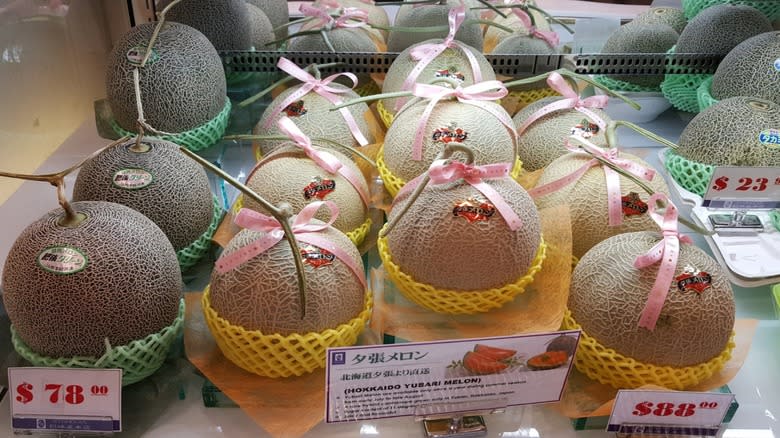
Before World War II, residents of the city of Yubari in Hokkaido cultivated cantaloupes. Unfortunately, the war interrupted their efforts, and afterward, they crew other crops, to disappointing results. Rather than give up, they created a hybrid melon, crossbreeding their cantaloupe seeds with a breed from Europe, and the Yubari King melon was born.
Many call it the most expensive melon in the world. Similar to crown melons, Yubari King melons are only grown in Yubari. They, too, receive meticulous care during cultivation, a period of 105 days that starts in February and ends in September, and must meet exacting standards to earn the Yubari King designation. These orange-fleshed melons are graded on sweetness and appearance. If they don't meet the standard, they are instantly rejected, leaving only the finest melons.
Yubari King melons have received high offers on auction. In 2019, a pair of Yubari Kings sold for 5 million yen, equivalent to roughly $30,000.
Read the original article on Tasting Table.

